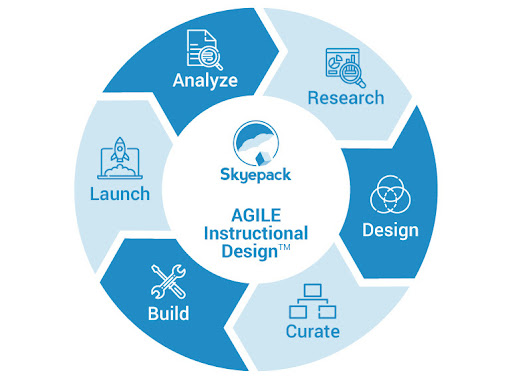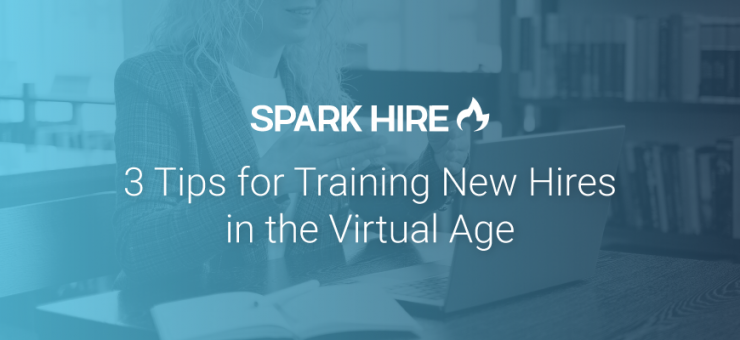COVID-19 forced your business to shift many—if not all—of its operations online.
You’ve probably transitioned meetings from conference rooms to Zoom, in-person interviews to video interviews, and water-cooler conversations with coworkers to Slack or email. It’s a virtual world we’re living in, and at least some of these digital practices are likely to persist even after it’s safe to return to the office.
A particularly challenging aspect of conducting business virtually is onboarding new team members remotely. The onboarding process even in the office can be overwhelming for new hires and hiring managers alike. When so much of joining a company seems dependent on in-person interaction, education, and assimilation, how can you successfully train new employees virtually to boost their productivity, engagement, and retention?
At Skyepack, we understand the unique challenges and opportunities presented by an online learning environment. We’ve crafted countless custom digital courses for businesses, universities, and associations, and over the years we’ve learned the ins and outs of engaging virtual learning experiences. In this article, we’ll cover three tips for training your company’s new hires virtually:
- Adapt your traditional onboarding process.
- Consider designing a new hire orientation course.
- Collect virtual onboarding feedback.
A strong virtual training program will make sure your new hires feel welcomed and have access to all of the information they need to succeed at your company. Let’s dive in.
1. Adapt your traditional onboarding process.
As you consider the implications of shifting your onboarding process to the virtual sphere, it’s important that your team remains flexible. It’s probably not a good idea to just take your typical Day 1 for new hires and just shift every meeting to Zoom, leaving everything else the same.
The virtual learning environment—even with live teaching capabilities—is different from an in-person “classroom.” There is less accountability, less opportunity to engage, and often, more distractions. Attention spans for virtual training sessions are likely even shorter than they are in person, so steer away from lengthy video trainings and meetings.
Instead, divide your traditional training process into manageable chunks. This may mean your onboarding process will stretch out across a week or two instead of the standard day or two, but your new hires will benefit from the altered format. Think: would you really want to watch an 8-hour video training session in one day? Probably not.
Some other essential ways to adapt your onboarding process for a virtual environment include:
- Increase communication: Starting a new job is a vulnerable experience. Especially virtually, new hires may be hesitant to reach out to ask questions as often as they have them. To accommodate this, increase the level of communication you usually have with new hires. Schedule more regular check-ins with supervisors, HR, and other team members to make sure their onboarding experience is on the right track.
- Assign new hire mentors or buddies: If you didn’t have a new hire mentor program before you went virtual, it’s a wise addition to make now. It’s important for new hires to have a peer—not necessarily an authority figure—to whom they can turn with inquiries and challenges. In the office, new employees can stop by a coworker’s desk and ask a quick question. Virtually, that’s not the case. A new hire mentor provides a less formal resource for your new hires and also helps them assimilate into company culture.
- Be as engaging as possible: It can make a significant difference in the level of audience engagement if trainers constantly prioritize holding the audience’s attention. In video trainings, this might mean increasing the volume of your voice, using your hands as you talk, and breaking up serious material with casual questions and conversation. The more dynamic you are, the more engaged your trainees will be and the more they’ll learn. The same principle applies to prepared training materials, which we’ll cover more in-depth in the next section.
As Web Courseworks points out, it’s also important to have a backup plan in case of technical difficulties. Have an IT professional or “Zoom producer” on-hand in your virtual onboarding meetings to deal with any such difficulties as they arise, so the facilitator can focus on delivering training content even through technical hiccups.
2. Design a new hire orientation course.
While virtual Zoom training can be used in combination with Google docs, PDFs, and other training resources to complete your virtual onboarding process, it’s wise to consolidate some aspects of the onboarding process into a single digital content delivery platform.
Designing a digital training course rather than implementing a series of piecemeal training sessions and documents can help new hires keep track of their accomplished tasks, understand where they are in the process, and provide a clear picture for the rest of their onboarding experience. As we outline in this guide to digital course materials, there are several benefits to hosting a course on a centralized digital platform:
- Convenience and portability: With all of the most essential information in one place, new hires will be able to easily reference needed information without having to search through a wealth of individual folders, documents, and spreadsheets. Plus, they could access the platform from a phone or tablet.
- Continued use: Even as your new hires gain experience at your company, they still may find themselves needing to reference some of the training materials they received in onboarding. With a centralized digital training course, their access never expires, and they can refer back to any module in the course at any time.
- Customization: There’s no need to rely on a single training manual your company has used for years. With a digital training course and help from a skilled instructional design team, it’s possible to draw information from multiple sources—past training, videos, instructional guides—and consolidate the information into one customized, valuable resource.
- Engagement opportunities: A digital course platform like Skyepack allows for the inclusion of multimedia and interactive content like checklists, assessments, drag-and drop elements, and animations to keep your new hires engaged. Studies show that interactive activities are more effective than reading and listening at helping people retain information, so you’ll want to incorporate interactive elements in your onboarding process.
With a dedicated online course for employee training, you can provide a streamlined, custom virtual experience for your remote new hires. They’ll appreciate having a centralized, convenient resource to refer back to throughout training and beyond.
3. Collect virtual onboarding feedback.
At Skyepack, we design top-notch customized courses, but you’ll never hear us claim to produce a perfect course, class, or training. That’s because there is always room for improvement, no matter how great your instructional design and course materials are.
We’re so committed to making continuous improvements to our courses that our curriculum development process happens in a loop, not a line. In other words, once your virtual training process has been designed, built, and implemented, your journey still isn’t over. To make the cycle complete, it’s necessary to analyze the efficacy of your training, collect feedback, make improvements, and launch the course again for your next cohort of new hires.
We call this an iterative approach because the course aligns more and more closely with your audience’s needs as it iterates, or repeats. You can visualize the iterative approach like this:

So how do you go about collecting feedback from your new hires? We’d recommend that you distribute anonymous surveys throughout the onboarding process. To get incremental feedback, you may want to ask for your new hires’ input about their very first day, their first week, and other specific time periods, as well as feedback regarding specific elements of their training and education.
Ask your new hires to rate different aspects of their training experience from 1-10, including the content and organization of whatever written materials and assignments they received. Add their suggestions to your company’s performance management system for regular review. This way, you’ll be best positioned to make specific, helpful changes to your onboarding process to benefit your next cohort.
Onboarding is a nerve wracking process for any new hire, and going through the process virtually can be even more daunting and uncomfortable. A successful virtual onboarding program includes flexibility, feedback, and a comprehensive training course that leaves each new team member empowered with information and excited to begin their new journey at your company.
About the Author
 Brady is a “reformed engineer turned entrepreneur”. After engineering gigs at two Fortune 100 companies, Brady left the corporate world to pursue a business degree and seek out new challenges. Brady’s passion for education stems from his desire to “always be learning” and find innovative solutions to difficult problems. Brady enjoys family outings to the park, explaining the answers of “Life, the Universe, and Everything” to his daughters, and reading just about anything (favorites are classics, popular fiction, and biographies).
Brady is a “reformed engineer turned entrepreneur”. After engineering gigs at two Fortune 100 companies, Brady left the corporate world to pursue a business degree and seek out new challenges. Brady’s passion for education stems from his desire to “always be learning” and find innovative solutions to difficult problems. Brady enjoys family outings to the park, explaining the answers of “Life, the Universe, and Everything” to his daughters, and reading just about anything (favorites are classics, popular fiction, and biographies).











